DAB & FM Radio
The digital switchover affects only TV services - at present there are no plans to change or remove FM radio. Although DAB is promoted as being the digital alternative to FM, many people still use (and prefer) FM radio.
With the digital switchover for TV, part of the same frequency spectrum will be used for the Freeview service. DAB doesn't use the same frequency spectrum as FM radio, and both services use considerably less spectrum than TV since there is no video content.
The following chart indicates the FM frequency range (88 - 108MHz), the DAB frequency range (217.5 - 230MHz) and the UHF TV frequency range (470 - 854MHz). The pink blocks indicate the spectrum that will be become free after the digital switchover:
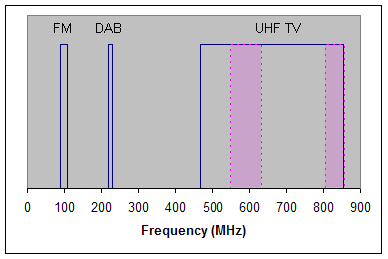
FM Radio
FM provides a small number of high quality analogue stereo radio programmes, provided by a conventional transmission network across the country.
Transmitters in different reception areas are on different frequencies to avoid interference, which typically gives several tuned responses for each of the main BBC stations. Even local radio stations may be present at two or three positions on the dial. One of the issues with FM radio is the need to re-tune when travelling in a car, to maintain optimum reception.
FM transmissions in the South-West primarily come from North Hessary Tor (close to the prison at Princetown on Dartmoor). The BBC radio transmitters web page shows the main transmitter locations. Clicking on one of these shows the associated relay transmitters. For North Hessary Tor, this includes Beacon Hill, which uses slightly different frequencies.
Although the transmitter at North Hessary Tor is high power (160kW), the signal from Beacon Hill (1kW) typically provides a stronger signal in Torbay. One factor that makes a significant difference to the FM received signal power is the polarisation of the FM aerial. North Hessary Tor transmits "mixed" polarisation, which means it transmits both horizontal and vertical polarisation at the same time. To receive this, the FM aerial can be correspondingly mounted either horizontal or vertical (or indeed slanted). The polarisation from Beacon Hill is vertical only - hence a horizontal aerial will pick up signals from North Hessary Tor, but a vertical aerial will pick up the stronger signals coming from Beacon Hill.
Beacon Hill transmits all the main BBC radio programmes, but it doesn't transmit Classic FM. This signal has to come from North Hessary Tor, since that's the nearest transmitter that carries it.
The following measurements show the signals that can typically be received on FM locally, together with the associated signal strength when using either a horizontally or a vertically polarised 3 element FM aerial:| Polarisation | ||||
| Transmitter | Service | Frequency (MHz) | Vertical (dBµV) | Horizontal (dBµV) |
|---|---|---|---|---|
| North Hessary Tor | BBC R2 | 88.1 | 49 | 61 |
| Beacon Hill | BBC R2 | 88.7 | 65 | 54 |
| Oxford | BBC R2 | 89.5 | 24 | 19 |
| NHT | BBC R3 | 90.3 | 49 | 60 |
| BH | BBC R3 | 90.9 | 61 | 48 |
| OX | BBC R3 | 91.7 | 26 | 22 |
| NHT | BBC R4 | 92.5 | 52 | 58 |
| BH | BBC R4 | 93.1 | 66 | 40 |
| OX | BBC R4 | 93.9 | 25 | 22 |
| BH | Gemini FM | 96.4 | 66 | 68 |
| NHT | BBC R1 | 97.7 | 56 | 58 |
| BH | BBC R1 | 98.4 | 68 | 55 |
| OX | BBC R1 | 99.1 | 24 | |
| NHT | Classic FM | 100.0 | 59 | 59 |
| Totnes | South Hams | 100.5 | 29 | 29 |
| Dartmouth | South Hams | 100.8 | 38 | 27 |
| Kingsbridge | South Hams | 101.2 | 39 | 30 |
| Stockland Hill | Gemini FM | 103.0 | 25 | |
| NHT | BBC R Devon | 103.4 | 44 | 47 |
| BH | BBC R Devon | 104.3 | 71 | 50 |
| BH | Palm FM | 105.5 | 69 | 64 |
Putting the data into a chart format:
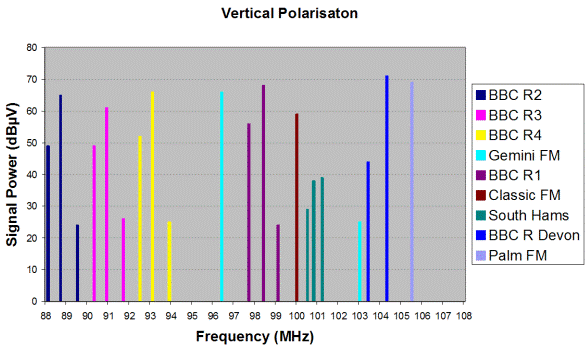
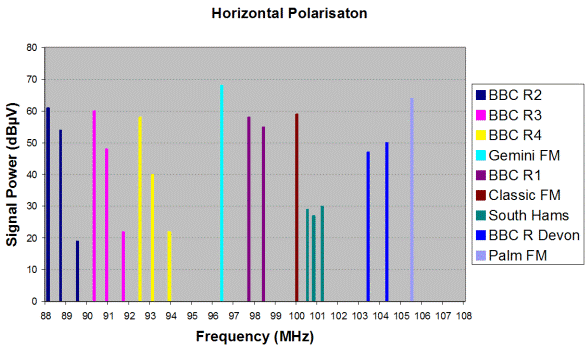
The DTG recommendation for FM radio signal strength (for stereo) is between 54 and 74dBµV, with a signal to noise ratio of at least 45dB. Many modern FM radios will typically give adequate stereo reception with a signal of 40dBµV. A weaker signal will give some "hiss" on stereo reception, though this can be eliminated by switching to mono reception. The minimum sensitivity for mono reception is around 20dBµV
In terms of the optimum orientation for an FM receiving aerial, horizontal polarisation gives better signals from NHT's mixed polarisation signals (at least in the location used for this test). The local radio stations work better with vertical polarisation, which also gives higher signals on the main stations (coming from Beacon Hill). Although a vertical aerial appears to work slightly better, an FM aerial is easier to mount on a vertical mast if it has a horizontal polarisation, since the mast itself doesn't interact with the dipole.
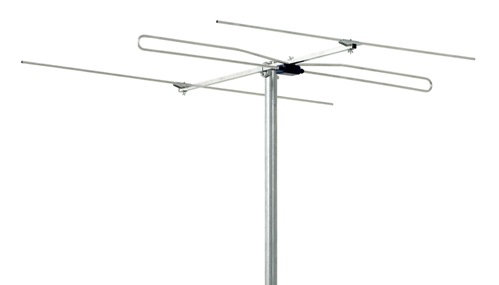
Mounting an FM aerial in the loft can be a viable option. Since the FM frequencies are significantly lower than TV, they diffract better around obstacles (so are less affected by terrain) and are attenuated less by roof tiles (<2dB for roof tiles, provided they have no significant metallic content - some concrete tiles can have a much higher loss). A foil lining (e.g on roof insulation) will however completely shield the signal, and require the aerial to be mounted outside.
DAB Radio
DAB radio stations have the same frequency at all transmitters across the whole of the UK. This is possible because of the COFDM digital transmission format, which enables the use of a "single frequency network". This is an advantage in principle for car radios, since re-tuning isn't be required.
One of the issues with DAB currently is that sufficient transmitters to provide optimum coverage aren't yet available, so the take up of DAB (including car radios) hasn't been high.
Another issue with DAB is audio quality. At the outset, DAB stations were allocated a high data rate giving excellent sound quality. More recently, this bandwidth has been reduced, with the sound quality suffering accordingly. The digital radio offered on satellite transmission currently has a better quality than DAB.
DAB is transmitted with vertical polarisation, so there's no debate about the mounting orientation of the aerial. The DAB operating frequency (around 200MHz) makes the dipole slightly less than half the size of an FM aerial:
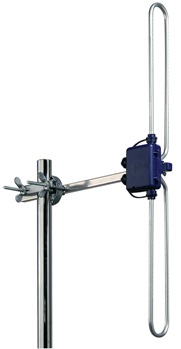
The DTG recommendation for DAB signal strength is 30dBµV to 65dBµV, with a C/N ratio of at least 18dB. In Torbay, the DAB signals are transmitted from both Beacon Hill and North Hessary Tor, and can acheive levels of around 70dBµV.
The DAB frequency spectrum is divided into 7MHz chunks (apart from block 13 which has a couple of extra MUXs added, making it bigger), subdivided into individual ensembles or MUXs. Out of all this available space, only three MUXs carry any services at present for the South-West:
| MUX | Centre Freq (MHz) | Name |
|---|---|---|
| 5A 5B 5C 5D | 174.928 176.640 178.352 180.064 | |
| 6A 6B 6C 6D | 181.936 183.648 185.360 187.072 | |
| 7A 7B 7C 7D | 188.928 190.640 192.352 194.064 | |
| 8A 8B 8C 8D | 195.936 197.648 199.360 201.072 | |
| 9A 9B 9C 9D | 202.928 204.640 206.352 208.064 | |
| 10A 10B 10C 10D | 209.936 211.648 213.360 215.072 | |
| 11A 11B 11C 11D | 216.928 218.640 220.352 222.064 | NOW Exeter & Torbay Digital1 Network |
| 12A 12B 12C 12D | 223.936 225.648 227.360 229.072 | BBC National DAB |
| 13A 13B 13C 13D 13E 13F | 230.748 232.496 234.208 235.776 237.448 239.200 |
The three MUXs that are in use look like this on a spectrum analyser:
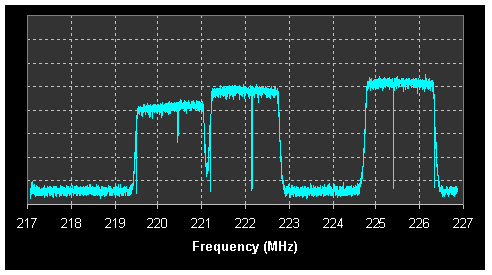
The radio stations available on the three MUXs are as follows:
| MUX | Station | Bit rate | Format |
|---|---|---|---|
| 11C | Traffic Chill Gold XFM UK BBC Devon KISS 101 Passion gemini | 48k 128k 128k 128k 128k 128k 96k 128k | Mono Stereo Stereo Stereo Stereo Stereo Mono Stereo |
| 11D | What's On talkSPORT Virgin Radio Classic FM Planet Rock BFBS theJazz Capital Life Birdsong | 8k 64k 160k 160k 128k 112k 128k 80k 160k | Data Mono Stereo Stereo Stereo Stereo Stereo Mono Stereo |
| 12B | BBC R1 r1 test BBC R2 BBC R3 BBC R4 BBC R5 Live BBC R5 Live SptsX BBC 1Xtra BBC 6 Music BBC R7 BBC Asian Network BBC World Serivce BBC Guide BBC Travel | 128k 8k 128k 192k / 160k 128k / 80k 64k 64k 128k 128k 80k 64k 64k 32k 32k | Stereo Data Stereo Stereo Mono Mono Mono Stereo Stereo Mono Mono Mono Data Data |
N.B. Although BFBS, theJazz and Capital Life show up in the list of available stations on a DAB radio, they seem to have stopped transmitting, so selecting any of these results in silence.
Each MUX in DAB has a width of 1.536MHz, and is capable of carrying 4 or 5 high quality radio stations (at a data rate of 256k), or 10 low quality radio stations (at a data rate of 128k). The MUXs are separated from each other by a guard band, which is mostly 0.176MHZ, but not always.
Straight away, some aspects of DAB look somewhat unusual:
Very few MUXs are used.
The MUXs that are used are close together.
Some of the services are in mono.
Some services use a higher bit rate than others.
Compared with FM, the usage of the DAB frequency spectrum looks odd - out of a sizeable frequency allowance, only three MUXs are being used; the rest is empty. This appears to have something to do with the cost of setting up DAB services, and may also explain why there aren't more programmes available yet.
The MUXs that are used are close together and are well "filled". This also appears to be related to the cost of establishing a DAB service - the stations that are provided haven't been allocated a sufficiently high bit rate to give the best audio quality, hence many hi-fi listeners may prefer FM radio.
The bit rate corresponding to audio quality is indicated below:
| DAB | Quality | DAB+ |
|---|---|---|
| 192k - 256k | Better than FM | 56k - 96k |
| 160k - 192k | Similar to FM | 40k - 64k |
| 128k - 160k | Worse than FM | 24k - 48k |
| <128k | "Annoying" | <24k |
Current DAB is shown on the left in the table above, and the compromise with squeezing all these stations onto just three MUXs results in reduced audio quality. BBC Radio 3 has the highest bit rate allocated, which brings it into the "similar to FM" category, with Birdsong getting the next highest allocation (yes - this really is a station that is transmitting the sound of birds singing - and nothing else!)
The current concerns with DAB audio quality are likely to remain until DAB+ is introduced. This uses a different audio compression method that isn't compatible with older DAB radios. Both services will continue for a while, but eventually everything is expected to become DAB+ only. Anyone thinking of getting a DAB radio should make sure it has DAB+ capability.
Three additional MUXs are present in the group, which don't quite fit in to the regular pattern shown further up this page - these do show up on a DAB radio that's tuned manually (but don't carry any programmes):
| MUX | Centre Freq (MHz) |
|---|---|
| 10N | 210.096 |
| 11N | 217.088 |
| 12N | 224.096 |
These MUXs appear to be a sub-set of the 10A, 11A and 12A MUXs. The exact purpose of these MUXs, and why they've been added, is a bit of a mystery - when I find out I'll add a note here!

